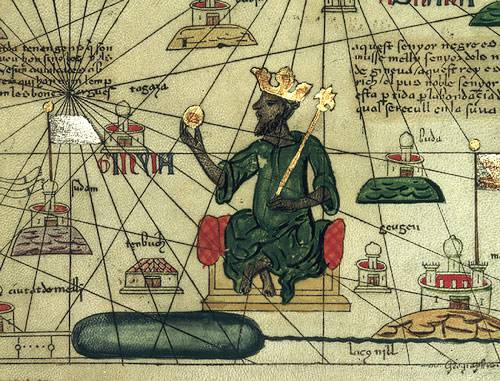
FAQ About Mansa Musa

Who was Mansa Musa?
Mansa Musa, also known as Musa I, was the ninth Emperor of the Mali Empire. He reigned from 1312 to 1337 and is famous for his immense wealth and significant influence in spreading Islam throughout West Africa. His empire was among the largest and richest in the world during his time.

Why is Mansa Musa considered the richest person in history?
Mansa Musa's wealth is often considered unparalleled because of the abundant gold resources of the Mali Empire. Mali was a major producer of gold, which was a highly valued commodity during that era. Mansa Musa's extravagant pilgrimage to Mecca further showcased his wealth, affecting economies as he distributed gold along his journey.

What was Mansa Musa's impact on the spread of Islam in West Africa?
Mansa Musa played a crucial role in spreading Islam throughout West Africa by establishing Islamic schools and mosques. His pilgrimage to Mecca was instrumental in establishing diplomatic and religious ties, thereby encouraging the spread of Islamic culture and education in the region.

What was the significance of Mansa Musa's pilgrimage to Mecca?
Mansa Musa's pilgrimage to Mecca in 1324 was significant for its demonstration of wealth and devotion to Islam. It included thousands of followers, camels, and servants, and he distributed vast amounts of gold to those he met along the way. This journey helped to establish diplomatic and economic ties between Mali and the broader Muslim world.

How did Mansa Musa's wealth affect the economies of the cities he visited during his pilgrimage?
During his pilgrimage, Mansa Musa distributed so much gold in regions like Cairo that it caused inflation and a significant economic impact. Gold's value decreased due to its abundance, which took years for some local economies to recover from.

What territories were included in the Mali Empire during Mansa Musa's reign?
The Mali Empire under Mansa Musa covered a vast area that included present-day Mali, Senegal, Gambia, Guinea, Niger, Nigeria, Chad, and Mauritania. It was a powerful and influential empire during the 14th century.

How did Mansa Musa contribute to education and culture in Mali?
Mansa Musa significantly contributed to education and culture by building numerous mosques and madrasas (Islamic schools), including the famous University of Sankore in Timbuktu. His reign attracted scholars, artists, and architects, transforming the region into a center of learning and culture.

What legacy did Mansa Musa leave behind?
Mansa Musa's legacy includes the expansion of the Mali Empire, the promotion of Islam in West Africa, and the establishment of Timbuktu as a center of knowledge and learning. His wealth and pilgrimage are remembered as symbols of Mali's prosperity and influence.

What was the architecture in Mali like during Mansa Musa's reign?
Architecture during Mansa Musa's reign was heavily influenced by Islamic designs, featuring mosques, palaces, and educational institutions. Notable examples include the Djinguereber Mosque and the University of Sankore in Timbuktu, known for their distinct use of mudbrick and Sudano-Sahelian design.

Did Mansa Musa have any successors, and how did the empire fare after his death?
After Mansa Musa, his son, Maghan I, succeeded him as emperor. However, Mali faced challenges and gradually declined due to internal strife and external pressures from other rising powers. The empire eventually fragmented into smaller states.

What were some of the primary economic activities in the Mali Empire during Mansa Musa's time?
The primary economic activities included gold mining, agriculture, and regional trade. Gold was the most significant source of wealth, making Mali one of the main suppliers to the Mediterranean and Middle Eastern markets. Salt and copper were also traded in exchange for goods like textiles and other imported commodities.

How did Mansa Musa's reign influence global perceptions of Africa?
Mansa Musa's reign elevated global awareness of Africa, especially regarding Mali's immense wealth and strategic location. His pilgrimage to Mecca, coupled with his generous wealth exhibitions, led to increased interest and interactions with European and Middle Eastern nations.

Has Mansa Musa's wealth been accurately quantified?
While Mansa Musa's wealth is frequently legendary and difficult to quantify accurately, his possession of gold and land wealth was immense by contemporary accounts. Various modern estimations adjusted for inflation suggest he might have been one of the richest individuals ever.

What did Mansa Musa achieve in terms of infrastructure development?
Mansa Musa was instrumental in developing infrastructure, such as building roads, mosques, and educational institutions. His investments in infrastructure improved trade routes and significantly enhanced the economic and cultural landscape of Mali.

Are there any surviving written records of Mansa Musa's reign?
There are no direct written records from Mansa Musa's reign by Malians themselves, as much of their history was orally transmitted. However, accounts from Arab scholars and travelers such as Ibn Battuta and al-Umari provide detailed descriptions of his empire.

What is the significance of the city of Timbuktu during Mansa Musa's era?
Timbuktu became a significant center of trade, culture, and Islamic scholarship during Mansa Musa's reign. It housed the famous University of Sankore, drawing scholars and students from different parts of the world and becoming pivotal in trans-Saharan trade.

Did Mansa Musa engage in diplomatic relations with other states?
Mansa Musa actively engaged in diplomatic relations, which his pilgrimage to Mecca exemplified. This journey highlighted Mali's power and contributed to establishing alliances and economic connections with various countries in the Islamic world.

What resources besides gold contributed to Mali's wealth under Mansa Musa?
Besides gold, significant contributors to Mali's wealth included trade in salt and copper. The empire was strategically positioned along vital trade routes, facilitating access to a variety of trade goods that enhanced their economic prosperity.

How did Mansa Musa's rule influence the artistic culture in Mali?
Mansa Musa's rule significantly influenced artistic culture through patronage of architecture and arts. His building of mosques and educational centers allowed for the flourishing of various art forms and brought in skilled artisans from across the Islamic world.

What were the religious policies under Mansa Musa's rule?
Mansa Musa was a devout Muslim, and his policies reflected his faith by promoting Islam as the state religion. He supported the construction of mosques and madrasas and appointed Islamic scholars and teachers to propagate the faith across his empire.
